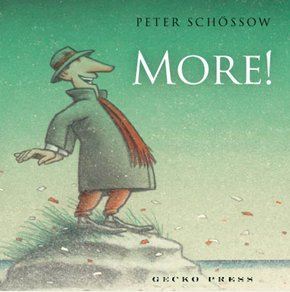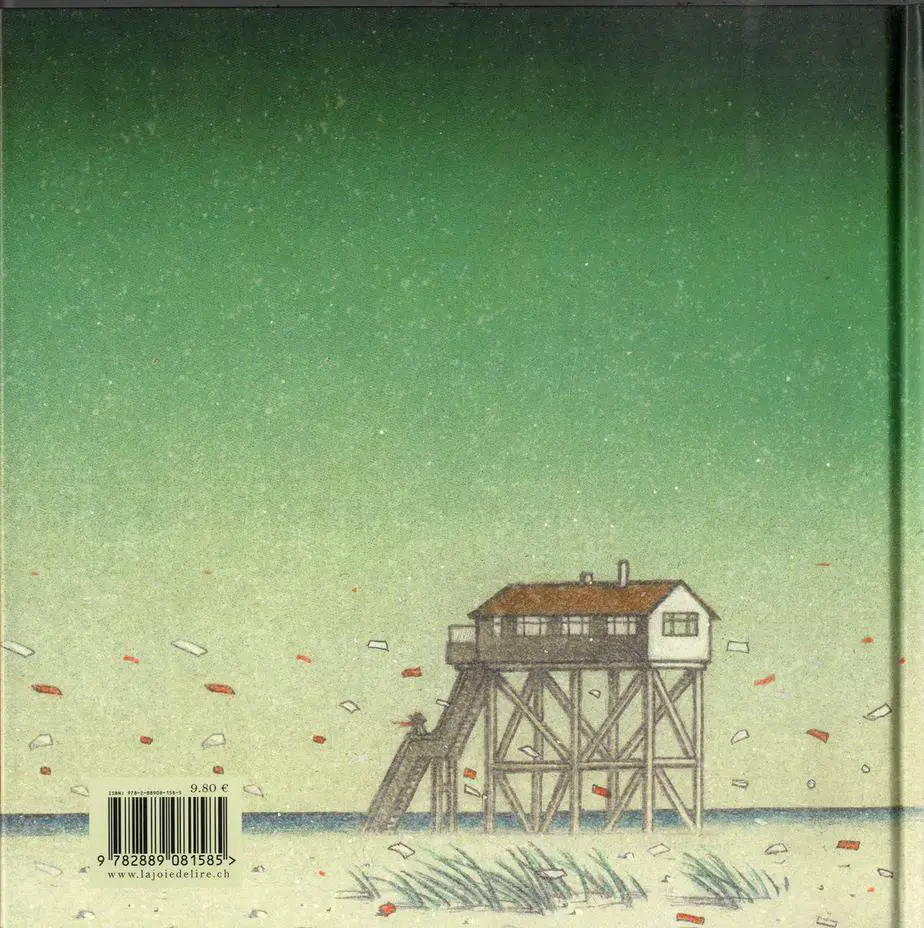Peter Schossow’s picture book More! is wordless in the same way Robert Redford’s All Is Lost is wordless: Both contain one spoken word, imbued with huge weight accordingly.

Gecko Press brought this book from German to English in 2010, and have also translated another of Schossow’s works: My First Car Was Red.
Even a ‘wordless’ picture book follows the typical story arc.
STORY STRUCTURE OF MORE!
SHORTCOMING
A man is small and helpless compared to the forces of nature.
DESIRE
The man would like to enjoy a walk along the shore.
OPPONENT
The wind, who blows off his hat.
PLAN
He will chase the hat.
BIG STRUGGLE
The big struggle takes place over a number of double spreads, and we see the man thrown higher and higher into the air, until he is level with an aeroplane.
ANAGNORISIS
He likes it!
NEW SITUATION
He will let himself get swept up in the wind again.

NOTES ON THE ILLUSTRATION OF MORE!
Ask a child the colour of sky and they’ll tell you ‘blue’. They get this from picturebooks, perhaps. In reality, the sky is many colours. But in this picturebook we have a distinctly green hue. Why? What was behind this choice?
Well, the thing about green is, it feels otherworldly. Green is associated with the subconscious; it’s thought we see green just before passing out (though I haven’t given this a go). The other thing is, a green sky means the sky is part of the land. There is no real distinction between land and sky. Did this story really happen, or is it entirely in the man’s imagination?
Notice the sun, also — this is not a distinctly delineated circle but rather a roundish glow, suggestive of some sort of magical haze. Yet at the end of the book we have a crescent moon. Over the course of a day the sky changes from bright to dark, but in this story the sky remains the same otherworldly hue of green. It’s only once you notice the moon that you realise the man has been flying in the wind all day. This is not the first time he’s asked to go again!
Though this is not a Christmas book, the colour palette is made up of green, white and the red of the man’s trousers and scarf. Red and green are complementary colours, so shouldn’t be commandeered by Christmas, sure.
This limited palette means the man is the same colour as the bits of rubbish blowing in the breeze.
This character has a very big nose. In fact, the nose is the first thing we see of him. I thought it was a chin. Then I realised the nose matches the shape of the shoes; these are big clodhoppers of shoes which should plant the man firmly upon the ground.
I’m left with one question though: What happened to his dog? Normally if the story starts with a dog it reappears on the final page. Did the dog get sick of him and go home alone? I believe the dog is an example of a picturebook McGuffin. The dog is the reason the man sets off on a walk in the first place, but after the inciting incident, the audience (generally) doesn’t think about the dog again. And it does work. For me, the dog’s fate was a refrigerator moment.
SEE ALSO
The colour of the sky in this picture book is a little unusual — green rather than standard blue. When the sky is green in art it often denotes the fantasy realm.
